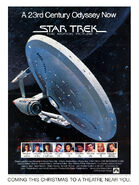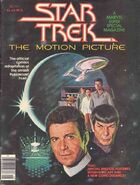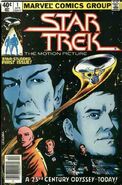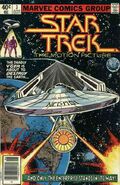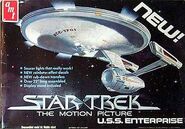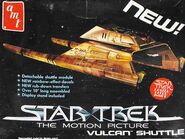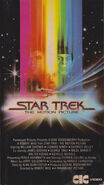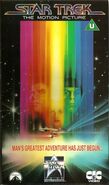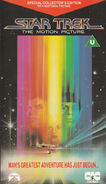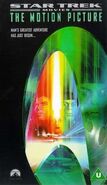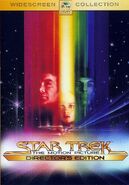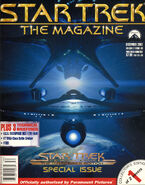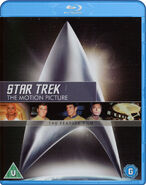m (→Visual effects: typo) |
m (→Production history: pic.add.) |
||
| Line 489: | Line 489: | ||
* {{d|21|October|1977}}: Livingston turns in his completed screenplay, 17 days overdue. (''The Lost Series'', p. 50) |
* {{d|21|October|1977}}: Livingston turns in his completed screenplay, 17 days overdue. (''The Lost Series'', p. 50) |
||
* {{d|22|October|1977}}: In a lengthy expose to hundreds of ''Star Trek'' fanclubs, Gene Roddenberry publicly announces what was already known for quite some time in production circles, that Leonard Nimoy will not reprise his role as Spock, finally confirming the rumors that had abounded for months. Negotiations with Nimoy had actually already been conducted since the 1975 ''The God Thing'' project, but by July it had become abundantly clear that Nimoy had emphatically declined the rigors of a weekly television show. It was for this reason that the Xon and Commander Decker characters, dividing between them the part Spock played on the ''Original Series'', were conceived for the new series. (''The Making of'', p. 39) |
* {{d|22|October|1977}}: In a lengthy expose to hundreds of ''Star Trek'' fanclubs, Gene Roddenberry publicly announces what was already known for quite some time in production circles, that Leonard Nimoy will not reprise his role as Spock, finally confirming the rumors that had abounded for months. Negotiations with Nimoy had actually already been conducted since the 1975 ''The God Thing'' project, but by July it had become abundantly clear that Nimoy had emphatically declined the rigors of a weekly television show. It was for this reason that the Xon and Commander Decker characters, dividing between them the part Spock played on the ''Original Series'', were conceived for the new series. (''The Making of'', p. 39) |
||
| − | + | [[File:Persis Khambatta screen tests for her role as Ilia.jpg|thumb|Khambatta's screen test on 27 October]] |
|
| + | * {{d|27|October|1977}}: Persis Khambatta holds her screen test and is signed the following day as Ilia. She does not need to have her head shaven yet on this occasion, instead she wears a bald cap. (''The Lost Series'', p. 54) |
||
* {{d|11|November|1977}}: The decision is made by the studio to upgrade ''Phase II'' from a television movie to a full-blown theatrical motion picture production, for which the budget, initially set at $15 million dollars by CEO [[Michael Eisner]], is by April 1978 already upped to $18 million dollars. (''The Making of'', pp. 47, 85; ''The Lost Series'', pp. 69, 75) |
* {{d|11|November|1977}}: The decision is made by the studio to upgrade ''Phase II'' from a television movie to a full-blown theatrical motion picture production, for which the budget, initially set at $15 million dollars by CEO [[Michael Eisner]], is by April 1978 already upped to $18 million dollars. (''The Making of'', pp. 47, 85; ''The Lost Series'', pp. 69, 75) |
||
* {{d|21|November|1977}}: The executive upgrade decision is disseminated through the lower production echelons, and production on ''Phase II'' is suspended in order to ascertain the requirements for a motion picture production, save for the construction of the studio models. The start on the new production is moved up to March or April 1978 in order to make the necessary upgrade changes to scripts, sets, wardrobes, production assets, etc. Production crew such as make-up artists, hair dressers, cameramen, stand-in performers, set dressers and the like, just hired that week, are immediately fired. Veterans Matt Jefferies and Jim Rugg by that time had already left the production earlier that month, the former to return to his regular job. (''The Making of'', p. 47) |
* {{d|21|November|1977}}: The executive upgrade decision is disseminated through the lower production echelons, and production on ''Phase II'' is suspended in order to ascertain the requirements for a motion picture production, save for the construction of the studio models. The start on the new production is moved up to March or April 1978 in order to make the necessary upgrade changes to scripts, sets, wardrobes, production assets, etc. Production crew such as make-up artists, hair dressers, cameramen, stand-in performers, set dressers and the like, just hired that week, are immediately fired. Veterans Matt Jefferies and Jim Rugg by that time had already left the production earlier that month, the former to return to his regular job. (''The Making of'', p. 47) |
||
Revision as of 14:32, 19 September 2014
Template:Realworld
"The Human adventure is just beginning..."
"Ten years ago, a television phenomenon became a part of life, shared in 47 different languages, read in 469 publications, and seen by 1.2 billion people. A common experience remembered around the world. Now Paramount Pictures brings the memory to life."
- - 1979 TV ad
After an eighteen-month refit process, the USS Enterprise is ready to explore the galaxy once again. But when a huge, invincible cloud approaches Earth, Admiral James T. Kirk must assume command of his old ship in order to stop it. Crew members old and new face new challenges, and must work together to triumph over the unknown.
Summary
Act one

Amar firing a photon torpedo at an unknown cloud
In Klingon space, three Klingon K't'inga-class battle cruisers are patrolling an area and encounter a huge cloud-like anomaly. On the bridge of IKS Amar, the captain orders his crew to fire torpedoes at it, but they have no effect. The captain orders retreat.
Meanwhile, in Federation space, a listening post, Epsilon IX, picks up a distress signal from one of the Klingon ships. As the three ships are attempting to escape the cloud, a "bolt" of plasma energy emerges and destroys each ship one by one. On Epsilon IX, the crew tracks the course of the cloud and discovers that it is headed for Earth.
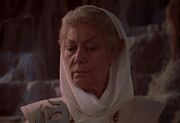
"You have not achieved kolinahr."
On Vulcan, Spock has been undergoing the kolinahr ritual, in which he has been learning how to purge all of his emotions, and is nearly finished with his training. The lead elder tells Spock of how their ancestors had long ago cast out all animal passions on those sands, and says that their race was saved by attaining kolinahr, which another elder describes as the final purging of all emotion. The lead elder tells Spock he has labored long and she prepares to give him a symbol of total logic. She is about to give him an necklace, when Spock reaches out and stops her, clearly disturbed by something out in space. She asks for a mind meld, to which Spock complies. She discovers that the alien intelligence which has called to him from deep space has stirred his Human half. She drops the necklace and says, "You have not yet achieved kohlinahr.", and then tells the other elders, "His answer lies elsewhere. He will not achieve his goal with us." Then she bids him farewell, telling him to "live long and prosper".
Meanwhile, at the Presidio campus of Starfleet Headquarters in San Francisco, Admiral James T. Kirk arrives in a shuttlecraft. As he steps out, he sees Commander Sonak, a Vulcan science officer who is joining the Enterprise crew and recommended for the position by Kirk himself. Kirk is bothered as to why Sonak is not on board yet. Sonak explains that Captain Decker, the new captain of the Enterprise, wanted him to complete his science briefing at Starfleet Headquarters before departing. The Enterprise has been undergoing a complete refitting for the past 18 months and is now under final preparations to leave, which would take at least 20 hours, but Kirk informs him that they only have 12. He tells Sonak to report to him on the Enterprise in one hour – he has a short meeting with Admiral Nogura and is intent on being on the Enterprise.
Following the meeting, Kirk transports to an orbital office complex of the San Francisco Fleet Yards and meets Montgomery Scott, chief engineer of the Enterprise. Scotty expresses his concern about the tight departure time. Kirk explains that an alien object is less than three days away from Earth, and the Enterprise has been ordered to intercept it because they are the only ship in range. Scotty says that the refit, a process that took eighteen months, can't be finished in 12 hours, and tries to convince him that the ship needs more work done as well as a shakedown cruise. Kirk insists that they are leaving, ready or not. They board a travel pod and begin the journey over to the drydock in orbit that houses the Enterprise.

"They gave her back to me, Scotty."
Scotty tells Kirk that the crew hasn't had enough transition time with all the new equipment and that the engines haven't even been tested at warp power, not to mention that they have an untried captain. Kirk tells Scotty that two and a half years as Chief of Starfleet Operations may have made him a little stale, but that he wouldn't exactly consider himself untried. Kirk then tells a surprised Scotty that Starfleet gave him back his command of the Enterprise. Scotty comments that he doubts it was so easy with Admiral Nogura, and Kirk tells him he's right. They arrive at the Enterprise, and Scotty gives Kirk a brief tour of the new exterior of the ship.

A transport goes bad
Upon docking with the ship, Scotty is called to Engineering. Kirk goes up to the bridge, and is informed by Lt. Commander Uhura that Starfleet has just transferred command from Captain Decker over to him, and she, along with several other crewmembers including Sulu and Chekov, step forward to greet Kirk, who appreciates the welcome but wishes it were under more pleasant circumstances. Kirk makes his way to the new engine room, where Captain Decker is assisting Scotty with launch preparations. He becomes visibly upset when Kirk tells him that he is assuming command. Decker will remain on the ship as as executive officer and temporarily demoted to commander. As Decker storms off, an alarm sounds. Someone is trying to beam over to the ship, but the transporter is malfunctioning. Kirk and Scotty race to the transporter room. Transporter operator Janice Rand is frantically trying to tell Starfleet to abort the transport, but it is too late. Commander Sonak and an unknown female officer are beaming in, but their bodies aren't re-forming properly in the beam. The female officer screams, and then their bodies disappear. Starfleet tells them that they have died. Kirk tells Starfleet to express his sympathies to their families.
In the corridor, Kirk sees Decker and tells him they will have to replace Commander Sonak and that he wants another Vulcan. Decker tells him that no one is available that is familiar with the ship's new design. Kirk tells Decker he will have to double his duties as science officer as well.
Kirk addresses the Enterprise crew
In the recreation room, as Kirk briefs the assembled crew on the mission, they receive a transmission from Epsilon IX. Commander Branch tells them they have analysed the mysterious cloud. It generates an immense amount of energy and measures 82 AUs (only 2 AUs in the director's edition) in diameter. There is also a vessel of some kind in the centre. They've tried to communicate with it, but there was no response. The lieutenant reports that further scans indicate something inside the cloud, but all scans get reflected back. It seems to think of the scans as hostile and attacks them. Like the Klingon ships earlier, Epsilon IX is destroyed.
Act two
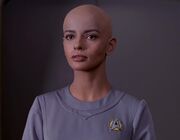
Lieutenant Ilia steps on the bridge
Later on the bridge, Uhura informs Kirk that the transporter is working now. Lt. Ilia, Deltan navigator arrives. Decker is happy to see her, as they developed a romantic relationship when he was assigned to her planet several years earlier. Ilia is curious about Decker's reduction in rank and Kirk interrupts and tells her about Decker being the executive and science officer. Decker tells her, with slight sarcasm, that Kirk has the utmost confidence in him. Ilia tells Kirk that her oath of celibacy is on record and asks permission to assume her duties. Uhura tells Kirk that one of the last few crew members to arrive is refusing to beam up. Kirk goes to the transporter room to ensure that the person beams up.
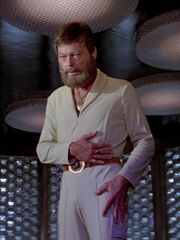
Dr. McCoy beams aboard
Kirk tells Starfleet to beam the officer aboard. Dr. McCoy materializes on the platform. McCoy is angry that his Starfleet commission was reactivated. He realizes that Kirk is responsible for the draft. His attitude changes, however, when Kirk says he desperately needs him. McCoy leaves to check out the new sickbay.
The crew finishes its repairs and the Enterprise leaves drydock and into the solar system.
- "Captain's log, star-date 7412.6. 1.8 hours from launch. In order to intercept the intruder at the earliest possible time, I must now risk engaging warp drive while still within the solar system."
Wormhole effect on the bridge of the USS Enterprise
Dr. McCoy comes up to the bridge and complains that the new sickbay is nothing but a computer centre. Kirk is anxious to intercept the cloud intruder, and orders Hikaru Sulu to go to warp speed. Suddenly, the ship enters a wormhole, which was created by an engine imbalance, and is about to collide with an asteroid that has been pulled inside. Kirk orders the phasers to be fired on it, but Decker tells Pavel Chekov to fire photon torpedoes instead. The asteroid and the wormhole are destroyed. Annoyed, Kirk wants to meet with Decker in his quarters. McCoy decides to come along.
Once in Kirk's quarters, Kirk demands an explanation from Decker. Decker pointed out that the redesigned Enterprise channelled the phasers through the main engines and because they were imbalanced, the phasers were cut off. Kirk acknowledged that he had saved the ship – however, he accuses Decker of competing with him. Decker tells Kirk that, because of his unfamiliarity with the ship's new design, the mission is in jeopardy. Decker tells Kirk that he will gladly help him understand the new design. Kirk then dismisses him from the room. In the corridor, Decker runs into Ilia. Ilia asked if the confrontation was difficult, and he tells her that it was about as difficult as seeing her again, and apologizes. She asked if he was sorry for leaving Delta IV, or for not saying goodbye. He said that if he had seen her again, would she be able to say goodbye? She says "no," and goes to her quarters nearby.
Back in Kirk's quarters, McCoy accuses Kirk of being the one who was competing, and the fact that it was Kirk who used the emergency to pressure Starfleet into letting him get command of the Enterprise. McCoy thinks that Kirk is obsessed with keeping his command. On Kirk's console viewscreen, Uhura informs Kirk that a shuttlecraft is approaching and that the occupant wishes to dock. Chekov also pipes in and replies that it appears to be a courier vessel. Kirk tells Chekov to handle the situation.
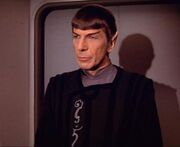
Spock arrives aboard the Enterprise
The shuttle approaches the Enterprise from behind, and the top portion of it detaches and docks at an airlock behind the bridge. Chekov is waiting by the airlock doors and is surprised to see Spock come aboard. Moments later, Spock arrives on the bridge, and everyone is shocked and pleased to see him, yet Spock ignores them. He moves over to the science station and tells Kirk that he is aware of the crisis and knows about the ship's engine design difficulties. He offers to step in as the science officer. McCoy and Dr. Christine Chapel come to the bridge to greet Spock, but he only looks at them coldly and does not reply to them. Uhura tries to speak to Spock, but he ignores her and tells Kirk that with his permission, he will go to engineering and discuss his fuel equations with Scotty. As Spock walks into the turbolift, Kirk stops him and welcomes him aboard. But Spock makes no reply and continues into the turbolift.
- "Captain's log, star date 7413.4. Thanks to Mr. Spock's timely arrival and assistance, we have the engines rebalanced into full warp capacity. Repair time, less than three hours. Which means we will now be able to intercept intruder while still more than a day away from Earth."
With Spock's assistance, the engines are now rebalanced for full warp capacity. The ship successfully goes to warp to intercept the cloud. In the officers lounge, Spock meets with Kirk and McCoy. They discuss Spock's kolinahr training on Vulcan, and how Spock broke off from his training to join them. Spock describes how he sensed the consciousness of the intruder, from a source more powerful that he has ever encountered, with perfect, logical thought patterns. He believes that it holds the answers he seeks. Uhura tells Kirk over the intercom that they have visual contact with the intruder.
A contact with the intruder is made
The cloud scans the ship, but Kirk orders no return scans. Spock determines that the scans are coming from the centre of the cloud. Uhura reports that she's transmitting full friendship messages on all frequencies, but there is no response. Decker suggests raising the shields for protection, but Kirk determines that that might be considered hostile to the cloud. Spock analyses the clouds composition, and discovers it has a 12-power energy field, the equivalent of power generated by thousands of starships.
Sitting at the science station, Spock awakens from a brief trance. He reveals to Kirk that the alien was communicating with him. The alien is puzzled – it contacted the Enterprise – why has the Enterprise not replied? Before they can think further, a red alert sounds, and an plasma bolt beam from within the cloud hits the ship, and begins to overload the ship's systems. Bolts of lightning surround the warp core and nearly injure some engineering officers, but Chekov was hurt – his hand is burned while sitting at the weapons station on the bridge. The bolt then finally disappears, and Scotty reports deflector power is down seventy percent. A medical team is called to the bridge, and Ilia is able to use her telepathic powers to soothe Chekov's pain.
Enterprise encounters V'ger's ship
Spock confirms to Kirk that the alien has been attempting to communicate. It communicates at a frequency of more than one million megahertz, and at such a high rate of speed, the message only lasts a millisecond. Spock programs to computer to send linguacode messages at that frequency. Another energy beam is sent out, but Spock transmits a message just in time, and the beam disappears. The ship continues on course through the cloud. They pass through many expansive and colorful cloud layers and upon clearing these, a giant vessel is revealed. Kirk asks for an evaluation and Spock reports that the vessel is generating a force field greater than the radiation of Earth's sun. Kirk tells Uhura to transmit an image of the alien to Starfleet, but she explains that any transmission sent out of the cloud is being reflected back to them. Kirk orders Sulu to fly above and along the top of the vessel.
As Enterprise moves in front of the alien vessel and holds position, an alarm sounds, and yet another energy bolt approaches the ship. The crew struggles to shield their eyes from its brilliant glow. Chekov asks Spock if it is one of the alien's crew, and Spock replies that it is a probe sent from the vessel. The probe slowly moves around the room and stops in front of the science station. Bolts of lightning shoot out from it and surround the console – it is trying to access the ship's computer. Spock manages to smash the controls to prevent further access, and the probe gives him an electric shock that sends him rolling onto the floor. The probe approaches the navigation console and it scans Lt. Ilia. Suddenly, she vanishes, along with the probe.
Another alert goes off, reporting helm control has been lost. Spock reports they've been caught by a tractor beam and Kirk orders someone up to take the navigator's station. Decker calls for Chief DiFalco to come up to the bridge as Ilia's replacement. The ship travels deep into the next chamber. Decker wonders why they were brought inside – they could have been easily destroyed outside. Spock deduces that the alien is curious about them. Uhura's monitor shows that the aperture is closing – they are trapped. The ship is released from the tractor beam and suddenly, an intruder alert goes off. Someone has come aboard the ship and is in the crew quarters section.
Act three
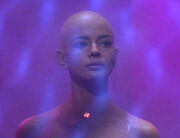
Ilia returns as V'ger's probe
Kirk and Spock arrive inside a crewman's quarters to discover that the intruder is inside the sonic shower. It is revealed to be Ilia, although it isn't really her – there is a small red device attached to her neck. In a mechanized voice, she replies, "You are the Kirk unit, you will listen to me." She explains that she has been programmed by an entity called "V'ger" to observe and record the normal functions of the carbon-based units "infesting" the Enterprise. Kirk opens the shower door and "Ilia" steps out, wearing a small white garment that just materialized around her. Dr. McCoy and a security officer enter the room, and Kirk tells McCoy to scan her with a tricorder.
Kirk asks her who V'ger is. She replies, "V'ger is that which programmed me." McCoy tells Kirk that Ilia is a mechanism and Spock confirms she is a probe that assumed Ilia's physical form. Kirk asks where the real Ilia is, and the probe states that "that unit" no longer functions. Kirk also asks why V'ger is traveling to Earth, and the probe answers that it wishes to find the Creator, join with him, and become one with it. Spock suggests that McCoy perform a complete examination of the probe.
"Ilia" is being examined
In sickbay, the Ilia probe lays on a diagnostic table, its sensors slowly taking readings. All normal body functions, down to the microscopic level, are exactly duplicated by the probe. Decker arrives and is stunned to see her there. She looks up at him and addresses him as "Decker", rather than "Decker unit," which intrigues Spock. Spock talks with Kirk and Decker in an adjoining room, and Spock locks the door. Spock theorizes that the real Ilia's memories and feelings have been duplicated by the probe as well as her body. Decker is angry that the probe killed Ilia, but Kirk convinces him that their only contact with the vessel is through the probe, and they need to use that advantage to find out more about the alien. Suddenly, the probe bursts through the door, and demands that Kirk assist her with her observations. He tells her that Decker will do it with more efficiency. After Decker and the probe leave, Spock expresses concern to Kirk of that being their only source of information.
Captain's log, stardate 7414.1: Our best estimates place us some four hours from Earth. No significant progress thus far reviving Ilia memory patterns within the alien probe. This remains our only means of contact with our captor.
Decker and Ilia are seen walking around in the recreation room. He shows her pictures of previous ships that were named Enterprise. Decker has been trying to see if Ilia's memories or emotions can resurface, but to no avail. Kirk and McCoy are observing them covertly on a monitor from his quarters. Decker shows her a game that the crew enjoys playing. She is not interested and states that recreation and enjoyment has no meaning to her programming. At another game, which Ilia enjoyed and nearly always won, they both press one of their hands down onto a table to play it. The table lights up, indicating she won the game, and she gazes into Decker's eyes. This moment of emotion ends suddenly, and she returns to normal. "This device serves no purpose."
"Why does the Enterprise require the presence of carbon units?", she asks. Decker tells her the ship couldn't function without them. She tells him that more information is needed before the crew can be patterned for data storage. Horrified, he asks her what this means. "When my examination is complete, all carbon units will be reduced to data patterns." He tells her that within her are the memory patterns of a certain carbon unit. He convinces her to let him help her revive those patterns so that she can understand their functions better. She allows him to proceed.
Meanwhile in one of the ship's airlocks, Spock slips up behind the airlock technician and nerve pinches him into unconsciousness.
Decker, the probe, Dr. McCoy, and Dr. Chapel are in Ilia's quarters. Dr. Chapel gives the probe a decorative headband that Ilia used to wear. Chapel puts it over "Ilia's" head and turns her toward a mirror. Decker asks her if she remembers wearing it on Delta IV. The probe shows another moment of emotion, saying Dr. Chapel's name, and putting her hand on Decker's face, calling him Will. Behind them, McCoy reminds Decker that she is a mechanism. Decker asks "Ilia" to help them make contact with V'ger. She says that she can't, and Decker asks her who the Creator is. She says V'ger does not know. The probe becomes emotionless again and removes the headband.
Spock is now outside the ship in a space suit with an attached thruster pack. He begins recording a log entry for Kirk detailing his attempt to contact the alien. He activates a panel on the suit and calculates thruster ignition and acceleration to coincide with the opening of an aperture ahead of him. He hopes to get a better view of the spacecraft interior.
Kirk comes up to the bridge and Uhura tells him that Starfleet signals are growing stronger, indicating they are very close to Earth. Starfleet is monitoring the intruder and notifies Uhura that it is slowing down in its approach. Sulu confirms this and says that lunar beacons show the intruder is entering into orbit. Chekov tells Kirk that Airlock 4 has been opened and a thruster suit is missing. Kirk figures out that Spock has done it, and orders Chekov to get Spock back on the ship. He changes his mind, and instead tells him to determine his position.
Spock touches a button on his thruster panel and his thruster engine ignites. He is propelled forward rapidly, and enters the next chamber of the vessel just before the aperture closes behind him. The thruster engine shuts down, and the momentum carries Spock ahead further. He disconnects the thruster pack from his suit and it falls away from him.
Continuing his log entry, Spock sees an image of what he believes to be V'ger's homeworld. He passes through a tunnel filled with crackling plasma energy, possibly a power source for a gigantic imaging system. Next, he sees several more images of planets, moons, stars, and galaxies stored and recorded. Spock theorizes that this may be a visual representation of V'ger's entire journey. "But who or what are we dealing with?", he ponders.
Spock attempts mind meld with V'ger
He sees the Epsilon IX station, and notes to Kirk that he is convinced that all of what he is seeing is V'ger, and that they are inside a living machine. Then he sees a giant image of Lt. Ilia with the sensor on her neck. Spock decides it must have some special meaning, so he attempts to mind meld with it. He is quickly overwhelmed by the multitude of images flooding his mind, and falls back unconscious.

Spock in sickbay
Kirk is now in a space suit and has exited the ship. The aperture in front of the Enterprise opens, and Spock's unconscious body floats toward him. Later, Dr. Chapel and Dr. McCoy are examining Spock in sickbay. Dr. McCoy performs scans and determines that Spock endured massive neurological trauma from the mind meld. Spock tells Kirk he should have known and Kirk asks if he was right about V'ger. Spock calls it a conscious, living entity. Kirk explains that V'ger considers the Enterprise a living machine and it's why "Ilia" refers to the ship as an entity and the crew as an infestation.
Spock describes V'ger's homeworld as a planet populated by living machines with unbelievable technology. But with all that logic and knowledge, V'ger is barren, with no mystery or meaning. He momentarily lapses into sleep but Kirk rouses him awake to ask what Spock should have known. Spock grasps Kirk's hand and tells him, "This simple feeling is beyond V'ger's comprehension. No meaning, no hope. And Jim, no answers. It's asking questions. 'Is this all that I am? Is there nothing more?'"
Uhura chimes in and tells Kirk that they are getting a faint signal from Starfleet. The intruder has been on their monitors for a while and the cloud is rapidly dissipating as it approaches. Sulu also comments that the intruder has slowed to sub-warp speed and is three minutes from Earth orbit. Kirk acknowledges and he, McCoy and Spock go up to the bridge.
Starfleet sends the Enterprise a tactical report on the intruders position. Uhura tells Kirk that V'ger is transmitting a signal. Decker and "Ilia" come up to the bridge, and she says that V'ger is signalling the Creator. Spock determines that the transmission is a radio signal. Decker tells Kirk that V'ger expects an answer, but Kirk doesn't know the question. Then "Ilia" says that the Creator has not responded. An energy bolt is released from V'ger and positions itself above Earth. Chekov reports that all planetary defense systems have just gone inoperative. Several more bolts are released, and they all split apart to form smaller ones and they assume equidistant positions around the planet.
McCoy notices that the bolts are the same ones that hit the ship earlier, and Spock says that these are hundreds of times more powerful, and from those positions, they can destroy all life on Earth. "Why?", Kirk asks "Ilia." She says that the carbon unit infestation will be removed from the Creator's planet as they are interfering with the Creator's ability to respond and accuses the crew of infesting the Enterprise and interfering in the same manner. Kirk tells "Ilia" that carbon units are a natural function of the Creator's planet and they are living things, not infestations. However "Ilia" says they are not true life forms like the Creator. McCoy realizes V'ger must think its creator is a machine.
Spock compares V'ger to a child, and suggests they treat it like one. McCoy retorts that this child is about to wipe out every living thing on Earth. To get "Ilia's" attention, Kirk says that the carbon units know why the Creator hasn't responded. The Ilia probe demands that Kirk "disclose the information." Kirk won't do it until V'ger withdraws all the orbiting devices. In response to this, V'ger cuts off the ship's communications with Starfleet. She tells him again to disclose the information. He refuses, and a plasma energy attack shakes the ship. McCoy tells Spock that the child is having a "tantrum."
Kirk tells the probe that if V'ger destroys the Enterprise, then the information it needs will also be destroyed. Ilia says that it is illogical to withhold the required information, and asks him why he won't disclose it. Kirk explains it is because V'ger is going to destroy all life on Earth. "Ilia" says that they have oppressed the Creator, and Kirk makes it clear he will not disclose anything. V'ger needs the information, says "Ilia." Kirk says that V'ger will have to withdraw all the orbiting devices. "Ilia" says that V'ger will comply, if the carbon units give the information.
Spock tells Kirk that V'ger must have a central brain complex. Kirk theorizes that the orbiting devices are controlled from there. Kirk tells "Ilia" that the information can't be disclosed to V'ger's probe, but only to V'ger itself. "Ilia" stares at the viewscreen, and, in response, the aperture opens and drags the ship forward with a tractor beam into the next chamber. Chekov tells Kirk that the energy bolts will reach their final positions and activate in 27 minutes. Kirk calls to Scotty on the intercom and tells him to stand by to execute Starfleet Order 2005 – the self-destruct command. A female crewmember asks Scotty why Kirk ordered self-destruct, and Scotty tells her that Kirk hopes that when they explode, so will the intruder.
The countdown is now down to 18 minutes. DiFalco reports that they have traveled 17 kilometers inside the vessel. Kirk goes over to Spock's station, and sees that Spock has been crying. "Not for us," Kirk realizes. Spock tells him he is crying for V'ger, and that he weeps for V'ger as he would for a brother. As he was when he came aboard the Enterprise, so is V'ger now – empty, incomplete, and searching. Logic and knowledge are not enough. McCoy realizes Spock has found what he needed, but that V'ger hasn't. Decker wonders what V'ger would need to fulfil itself.
Spock comments that each one of us, at some point in our lives asks, "Why am I here?" "What was I meant to be?" V'ger hopes to touch its Creator and find those answers. DiFalco directs Kirk's attention to the viewscreen. Ahead of them is a structure with a bright light. Sulu reports that forward motion has stopped. Chekov replies that an oxygen/gravity envelope has formed outside of the ship. "Ilia" points to the structure on the screen and identifies it as V'ger. Uhura has located the source of the radio signal and it is straight ahead. A passageway forms outside the ship as Kirk, Spock, McCoy, Decker, and "Ilia" enter a turbolift.
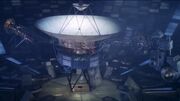
The heart of V'ger is revealed
The landing party exits an airlock on the top of the saucer section and walks up the passageway. At the end of the path is a concave structure, and in the center of it is an old NASA probe from three centuries earlier. Kirk tries to rub away the smudges on the nameplate and makes out the letters V G E R. He continues to rub, and discovers that the craft is actually Voyager 6. Kirk recalls the history of the Voyager program – it was designed to collect data and transmit it back to Earth. Decker tells Kirk that Voyager 6 disappeared through a then called black hole.
Kirk says that it must have emerged on the far side of the galaxy and got caught in the machine planet's gravity. Spock theorizes that the planet's inhabitants found the probe to be one of their own kind – primitive, yet kindred. They discovered the probe's 20th century programming, which was to collect data and return that information to its creator. The machines interpreted that instruction literally, and constructed the entire vessel so that Voyager could fulfill its programming. Kirk continues by saying that on its journey back, it amassed so much knowledge that it gained its own consciousness.
"Ilia" tells Kirk that V'ger awaits the information. Kirk calls Uhura on his communicator and tells her to find information on the probe in the ship's computer, specifically the NASA code signal, which will allow the probe to transmit its data. Decker realizes that that is what the probe was signalling – it's ready to transmit everything. Kirk then says that there is no one on Earth who recognizes the old-style signal – the Creator does not answer.
Kirk calls out to V'ger and says that they are the Creator. "Ilia" says that is not logical – carbon units are not true life forms. Kirk says they will prove it by allowing V'ger to complete its programming. Uhura calls Kirk on his communicator and tells him she has retrieved the code. Kirk tells her to set the Enterprise transmitter to the code frequency and to transmit the signal. Decker reads off the numerical code on his tricorder, and is about to read the final sequence, but Voyager burns out its own antenna leads to prevent reception.
"Ilia" says that the Creator must join with V'ger, and turns toward Decker. McCoy warns Kirk that they only have 10 minutes left. Decker figures out that V'ger wanted to bring the Creator here and transmit the code in person. Spock tells Kirk that V'ger's knowledge has reached the limits of the universe and it must evolve. Kirk says that V'ger needs a human quality in order to evolve. Decker thinks that V'ger joining with the Creator will accomplish that. He then goes over to the damaged circuitry and fixes the wires so he can manually enter the rest of the code through the ground test computer. Kirk tries to stop him, but "Ilia" tosses him aside. Decker tells Kirk that he wants this as much as Kirk wanted the Enterprise.
V'ger evolves into a higher form of existence after merging with Decker
Suddenly, a bright light forms around Decker's body. "Ilia" moves over to him, and the light encompasses them both as they merge together. Their bodies disappear, and the light expands and begins to consume the area. Kirk, Spock, and McCoy retreat back to the Enterprise. V'ger explodes, leaving the Enterprise above Earth, unharmed. On the bridge, Kirk wonders if they just saw the beginning of a new life form, and Spock says yes and that it is possibly the next step in their evolution. McCoy says that its been a while since he "delivered" a baby, and hopes that they got this one off to a good start.
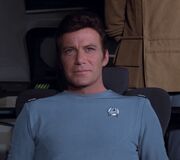
Kirk orders the Enterprise out for more adventures
Uhura tells Kirk that Starfleet is requesting the ship's damage and injury reports and vessel status. Kirk reports that there were only two casualties: Lt. Ilia and Captain Decker. He quickly corrects his statement and changes their status to "missing." Vessel status is fully operational. Scotty comes on the bridge and agrees with Kirk that it's time to give the Enterprise a proper shakedown. When Scotty offers to have Spock back on Vulcan in four days, Spock says that's unnecessary, as his task on Vulcan is completed.
Kirk tells Sulu to proceed ahead at warp factor one. When DiFalco asks for a heading, Kirk simply says "Out there, that-away."
With that, the Enterprise flies overhead and engages warp drive on its way to another mission of exploration and discovery.
- The Human adventure is just beginning.
Memorable Quotes
"Heading?"
"Sir, it's on a precise heading for Earth."
- - Branch asks an Epsilon crewmember about V'ger's destination
"They gave her back to me, Scotty."
- - Kirk, heading to the refitted Enterprise in a travel pod
"He wanted her back, he got her."
- - Sulu
"I'm replacing you as captain of the Enterprise. You'll stay on as executive officer, temporary grade reduction to commander."
"You personally are assuming command?"
"Yeah."
- - Kirk regaining captaincy of the Enterprise from Decker
"Mr. Scott, an alien object of unbelievable destructive power is less than three days away from this planet. The only starship in interception range is the Enterprise. Ready or not, she launches in twelve hours."
- - Kirk
"I'm sorry."
"No, sir. I don't think you're sorry. Not one damn bit. I remember when you recommended me for this command. You told me how envious you were, and how you hoped you'd be given a starship command again. Well sir, it looks like you found a way."
"Report to the bridge, Commander. Immediately."
"Aye, sir."
- - Kirk and Decker
"Admiral, we have just spent eighteen months redesigning and refitting the Enterprise. How in the name of hell do they expect me to have her ready in twelve hours?!"
- - Scott, to Kirk
"Ensign, the possibilities of returning from this mission in one piece may have just doubled."
- - Uhura
"Admiral, this is an almost totally new Enterprise. You don't know her a tenth as well as I do."
- - Decker to Kirk, on the new Enterprise
"Enterprise, what we got back didn't live long. Fortunately."
- - Starfleet transporter chief to Kirk, after the transporter malfunction
"Just a moment, captain, sir. I'll explain what happened. Your revered Admiral Nogura invoked a little known, seldom used reserve activation clause! In simpler language, captain, they drafted me!"
- - McCoy to Kirk, on returning to Starfleet
"Why is any object we don't understand always called a thing?"
- - McCoy
"Well, Jim, I hear Chapel's an MD now. Well, I'm gonna need a top nurse, not a doctor who'll argue every little diagnosis with me! And they've probably redesigned the whole sickbay, too! I know engineers. They love to change things!"
- - McCoy, on the new Enterprise
"Thrusters ahead, Mr. Sulu. Take us out!"
- - Kirk ordering the Enterprise out of drydock
"Well, Bones, do the new medical facilities meet with your approval?"
"They do not. It's like working in a damned computer center!"
- - Kirk and McCoy
"No casualties reported, doctor."
"Wrong, Mister Chekov, there are casualties. My wits! As in, frightened out of, captain, sir!"
- - Chekov and McCoy
"Mister Spock!"
"Well, so help me, I'm actually pleased to see you!"
- - Chapel and McCoy, as Spock arrives
"Spock, you haven't changed a bit. You're just as warm and sociable as ever."
"Nor have you, doctor, as your continued predilection for irrelevancy demonstrates."
- - McCoy and Spock
"Will you please sit down!!"
- - Kirk to Spock
"Moving into that cloud, at this time, is an unwarranted gamble."
"How do you define unwarranted?"
"You asked my opinion, sir."
- - Decker and Kirk
"This is how I define unwarranted!"
- - Decker to Kirk, after V'ger vaporizes Ilia
"I don't want him stopped! I want him to lead me to whatever is out there."
"And if that whatever has taken over his mind...?!"
"Then, he'll still have led me to it, won't he?"
- - Kirk and McCoy, on Spock
"Spock, this child is about to wipe out every living thing on Earth. Now what do you suggest we do? Spank it?"
- - McCoy, on the Ilia probe
"Your child is having a tantrum Mr. Spock!"
- - McCoy, after Kirk denies V'ger the wanted information
"I weep for V'ger as I would for a brother. As I was when I came aboard, so is V'ger now. Empty. Incomplete. Searching. Logic and knowledge are not enough."
- - Spock, with tears in his eyes
"Each of us, at some time in our life, turns to someone – a father, a brother, a god – and asks: Why am I here? What was I meant to be? V'ger hopes to touch its creator to find its answers."
""Is this all that I am? Is there nothing more?"
- - Spock and Kirk
"Touch God...? V'ger's liable to be in for one hell of a disappointment."
- - McCoy, after realizing that V'ger wishes to physically join with its creator
"Jim, I want this! As much as you wanted the Enterprise, I want this!"
- - Decker, before joining up with V'ger
"We witnessed a birth. Possibly a next step in our evolution."
"Well, it's been a long time since I delivered a baby and I hope we got this one off to a good start."
- - Spock and McCoy, on Decker's merger with V'ger
"List them as missing."
- - Kirk to Uhura, on Ilia and Decker
"Heading, sir?"
"Out there. Thataway!"
- - DiFalco and Kirk
Background Information
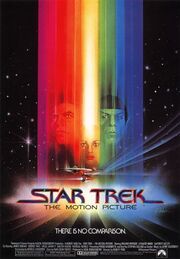
The theatrical poster for Star Trek: The Motion Picture
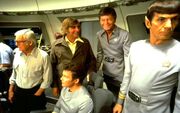
From left to right: Robert Wise, William Shatner, Gene Roddenberry, DeForest Kelley, and Leonard Nimoy
- This movie was the last Star Trek release to occur in the 1970s, and the only live-action one to take place in that decade.
- Grace Lee Whitney (Janice Rand) and Mark Lenard (Klingon captain) are the only actors, besides the original cast, to appear in both this film and the final Star Trek: The Original Series film, Star Trek VI: The Undiscovered Country. In The Motion Picture, Lenard played the captain of the lead Klingon vessel Amar and in The Undiscovered Country Lenard portrayed Sarek while in both films Whitney portrayed Janice Rand.
- Likewise, Majel Barrett and Leonard Nimoy are the only original series actors to participate in both this film and the first Star Trek movie set in the rebooted timeline, Star Trek. In The Motion Picture, Barrett played Dr. Chapel and in Star Trek she voiced the computer for the alternate Enterprise[!] and in both films Nimoy portrayed Spock (in the 2009 film he played the Spock of the original "Prime" timeline). However, James Doohan's son Chris also appeared in both this film and the 2009 movie. In The Motion Picture he is in the recreation deck scene (with his twin brother Montgomery) when Kirk addresses the entire crew; and in Star Trek he is in the transporter room scenes as an engineering lieutenant commander.
- Also, Nimoy is the only actor to participate in both this film and the final Star Trek movie to date, Star Trek Into Darkness. In both films, Nimoy portrayed Spock.
- Also, Barrett and Nimoy are the only two cast members from the original pilot "The Cage" to appear in this first Star Trek film. Nevertheless, Nimoy is the only actor to portray the same character in both productions, having played Spock in both, whereas Barrett played Number One in the pilot and Dr. Chapel in the movie.
- In his 1983 special Leonard Nimoy: Star Trek Memories, Leonard Nimoy spoke briefly about the film saying: "It was a very finely crafted film, and it did well. But from the actor's point of view frankly, it was frustrating. We didn't feel that we were getting to play the characters that we enjoyed playing in the way that we knew how to play them. And it was frustrating for Gene Roddenberry too. It wasn't the story or script he had wanted, and the gaps seemed filled with too much emphasis on special effects."
- According to the Guinness Book of Records, when the movie was produced, it was the most expensive film ever made with a total production cost of US$46 million dollar (or $44 million dollar, according to the reference book Star Trek Phase II: The Lost Series, p. 75). This proved incorrect however, as Superman: The Movie had an even higher budget at US$54 million, though the producers didn't give the exact figure for some years afterward. This doesn't take inflation into account, however; taking it into account, Cleopatra was, at the time, the most expensive film ever made. The budget for Star Trek: The Motion Picture included costs for the aborted Star Trek: Phase II series, as well as the earlier false starts in getting a Star Trek movie off the ground. The inclusion of these costs is debatable from a business economics point of view, since anywhere else in the corporate world research and development costs of projects that do not come to fruition are usually written off and are commonly charged against the balance sheets of corporations. This is a sound generally accepted business accounting principle (as stated in any business economics text book) since it prevents cost price inflation with undue elements, therefore avoiding pollution of their viability assessment, of products that do come to fruition. Still, in the particular case of Phase II, an argument could be made for carrying over production costs already incurred to the Motion Picture, since some of those costs were applicable to the Motion Picture as well, such as those of the sets that were already constructed and the fees for production staff and cast already paid, who continued to work on the movie.
- Star Trek: The Motion Picture was one of the last heavily-marketed, non-animated big studio films with just a G rating, and the only Star Trek film to receive this rating (although in 2001, the director's cut got a PG for sci-fi action and mild language). Ever since, such productions were released with at least a PG rating. (citation needed • edit)
- Principal photography, the filming of scenes which required the principal cast, began on 7 August 1978 and was finished on 26 January 1979.
- Bruce Logan was the director of photography for the Klingon scenes. He was scheduled to be the Director of Photography (DP) on "In Thy Image", the pilot for Phase II.
- Fred Phillips saved Leonard Nimoy's ear molds from the Original Series. They were put back into use when the molds being made for the film were damaged.
- Academy Award-winning film legend Orson Welles provided the narration for many of the film's trailers. Director Robert Wise worked as film editor on Welles' first two films, Citizen Kane and The Magnificent Ambersons.
- This film was pre-sold, while it was still in production, to the ABC TV network for US$15 million. That fee allowed two airings of the film, the first to run no earlier than December 1982. Its ABC premiere was on 20 February 1983, and its second run was in March 1987. (ABC ran the film a third and final time in the summer of 1989.) The television run of the movie marks one of the first times that scenes not incorporated into a theatrical cut were reintegrated for the television airing, making the television cut longer than the theatrical cut.
- The film earned US$11,926,421 in its opening weekend at the US box office, a record at the time.
- The world premiere of the film took place in Washington, DC, at the Smithsonian Institute on 6 December 1979 as a fund-raising event for the National Space Club. A black tie affair, it was followed by a reception with all the film's stars and Gene Roddenberry at the National Air and Space Museum, complete with an orchestra playing the Jerry Goldsmith theme. (Some internet sites incorrectly state it was at the Kennedy Center.)
- The theme from the TV series is heard three times in the film. Each time it is used, it is for a "captain's log" dictation. The first one is heard just before Kirk engages the Enterprise's first warp test. The second time is when Spock is making his repairs to the warp drive, and the third time is when Kirk and McCoy are watching Decker and the Ilia-probe from Kirk's quarters.
- This film, and the last TOS cast film (Star Trek VI: The Undiscovered Country), are the only two that do not use the original series fanfare in the opening credits of the film. That fanfare was not heard at all in the score to this film, and did not make an appearance until Star Trek II: The Wrath of Khan. Jerry Goldsmith did, however, bring the fanfare back for the subsequent Star Trek films he scored.
- Director Wise said in the DVD commentary track that out of the forty films he directed, Star Trek was the only one that never got a sneak preview. According to Wise, the special effects came in so late, they didn't have time to preview the film to an audience and get some feedback and so they were stuck with just dropping the expensive effects into the film and basically having to rely on them. Wise also mentioned that he literally carried the first print of the film to the premiere and it was loaded into the projectors as they waited in the theater. Then, after the world premiere, he and Gene Roddenberry considered doing some more work on the film, but Paramount overruled them, saying it might show a lack of confidence in the film if they did that. Wise also said that the Director's Edition is a tighter cut and more focused on the characters, within the restrictions of the film's story.
- Paramount sought and obtained a variety of design patents on some costumes, ships, and props from this movie.
- According to David Gerrold's The World of Star Trek, a blooper occurred in the scene where Kirk and Spock leave to investigate the intruder alert, William Shatner, as Kirk, tells Stephen Collins as Decker, that he has the bridge and Collins jumped down to the floor, grabbed the command chair and yelled like Daffy Duck, "It's mine! It's mine! At last it's mine! All mine!" which led Shatner to turn around and yell "I take it back!"
- In Gene Roddenberry's novelization of the film, the female lead Vulcan elder is given the name T'Sai.
- The five previous ships named Enterprise, which Decker shows the Ilia probe in the rec room are, according to Mike Okuda's DVD text commentary, an 18th century frigate, the much decorated World War II carrier, the space shuttle prototype, an unseen ship which was actually an early Matt Jefferies design for the TV Enterprise and of course, the original configuration of the Enterprise from the original series. Internet rumors from 2001 speculated that the unseen ship might be replaced by the NX-01 Enterprise; however, this did not happen. Christopher L. Bennett's novel Ex Machina establishes (albeit non-canonically) that the image of the NX-01 Enterprise was added after the events of this film. Incidentally, it was Jefferies, who had provided both the historical lineage concept and the artwork upon which the backlit transparencies of the vessels were based, for the Motion Picture's immediate predecessor, Phase II. It has set a tradition that was adhered to in the Star Trek: The Next Generation series and films, as well as in Star Trek: Enterprise. (The Making of Star Trek: The Motion Picture, p. 94)
- According to an article written by Harlan Ellison and published in Starlog magazine in 1980, Gene Roddenberry took Harold Livingston to arbitration with the Writer's Guild of America five times, seeking a screen credit for the film's screenplay. The Writer's Guild apparently sided with Livingston, as Roddenberry never received any credit for the script. However Alan Dean Foster did successfully arbitrate with the Writer's Guild as he had initially received no story credit at all, even though he had written an early draft of the "In Thy Image" script which was rewritten into the TMP script.
- This was the third of five official Star Trek productions to be adapted into View-Master reels.
- The Star Trek newspaper comic strip was launched in coordination with this movie, four days prior to its premiere. The character of Ilia is inexplicably featured in the first two story arcs, even though they take place after the events of the movie.
- The film was one of only a few Hollywood productions, and also one of the last along with Disney's The Black Hole, that introduces the film with an overture – a practice commonly used for "epic" movies. For that purpose, Jerry Goldsmith chose to present the auditory "Ilia's Theme", which he also referred to as a "love theme". The overture runs for approximately three minutes, and is then taken over by the film's concise main theme (which later became famous as TNG's main title) (20th Anniversary Special Edition soundtrack booklet).
- The V'ger sound effects were performed by the blaster beam – a musical instrument invented by former Star Trek actor Craig Huxley. The sound was created by several strings attached to an eighteen-foot aluminum body and amplified by motorized guitar pickups. The blaster beam effect was later reused in Star Trek II: The Wrath of Khan (during Kirk's battle with Khan in the Mutara Nebula) Star Trek III: The Search for Spock (very briefly, during the theft of the Enterprise from Spacedock) and in Star Trek: First Contact for the spacewalk sequence and Picard's final encounter with the Borg Queen.
- In his commentary on the Star Trek DVD, J.J. Abrams (who can be seen in the DVD's gag reel wearing a TMP production jacket) stated that the reveal of the new Enterprise[!] in that film was, as much as possible, intended as an homage to the "amazing" shuttle sequence where Kirk sees the refit Enterprise for the first time.
- The plot and script emerged from the unproduced pilot for Star Trek: Phase II, "In Thy Image". The film was adapted as a novel and as a three-part comic.
- Several props and costumes from this movie were sold off on the It's A Wrap! sale and auction on eBay, including Walter Koenig's uniform, [1] William Shatner's uniform, [2] a bio-monitor, [3] a beige class-B Starfleet uniform, [4] a brown class-A uniform belt, [5] several uniform patches, [6] [7] [8] a schematic lot of Enterprise deck one's exterior, [9] and many background uniforms and civilian costumes. [10] [11] [12]
- This film marks the first depiction of Earth in the 23rd century. Although a parkland near Christopher Pike's native Mojave was seen in TOS: "The Cage", this was merely an illusion created by the Talosians.
- The movie has received copious contemporary coverage in period magazines, most notably in movie and genre periodicals, Starlog magazine in particular. Yet, there was was one very remarkable exception; The usually very Star Trek friendly genre magazine Cinefantastique did not cover the movie at all, save for a short editorial article in Vol 9 #3/4, 1979. As it turned out however, extensive copy was written by freelance writer Preston Neal Jones for a planned The Motion Picture themed double-issue. Due to editorial problems because of the volume of text, that issue, despite advertisements in the magazine to the contrary, never came to fruition. However, 35 years after the movie's release, the text was announced as voluminous reference book for an October 2014 release as Return to Tomorrow - The Filming of Star Trek: The Motion Picture.
Dating
There is some debate over the dating of the first Star Trek movie. Startrek.com [13], Star Trek: Star Charts (p. 39) and the Star Trek Encyclopedia, (3rd ed., p. 691) written by Michael Okuda, places The Motion Picture in 2271, stating that it took place 2.5 years after the end of the last five-year mission that in turn took place from 2264 to 2269 according to Okuda. This was based on Decker's line to Kirk, that the latter had "not logged a single star-hour in the last two and a half years" and Kirk's line to Scotty, "Well, two and a half years as Chief of Starfleet Operations may have made me a bit stale, but I certainly wouldn't exactly consider myself untried." This indicates a minimum of two-and-a-half years between the time the Enterprise returned to dry dock and the beginning of the first movie.
On screen however, in VOY: "Q2" (that aired in 2001, after the latest edition of the Encyclopedia was published) it is stated that Kirk's five-year mission took place a year later, and ended in 2270. This would establish the earliest point at which The Motion Picture could have taken place some time in 2272 or 2273 (depending at what point in 2270 the ship ended the five-year mission). Furthermore, Roddenberry – in his novelization – has Spock note a more precise span of 2.8 years (nine Vulcan seasons) since he left the crew.
On the other end of the spectrum, the latest this film could have taken place is in 2278, since the red The Wrath of Khan-style uniforms were in use by some time that year based on TNG: "Cause and Effect". The stardates mentioned in the film cannot be used to accurately date the events, since the four digit stardates beginning with 7, were used for fifteen years between 2270 and 2284, based on "Bem", "The Ensigns of Command" and Star Trek II: The Wrath of Khan. For their 2006 chronology Voyages of Imagination, Pocket Books set the film in 2273. The novel Triangle, set after The Motion Picture, takes place seven years after "Amok Time", in 2274. Due to all this obscurity, Memory Alpha leaves the exact dating open, and simply dates the film at the 2270s.
Production
Visual effects
- The visual effects company Robert Abel & Associates (RA&A) was given the assignment to produce the film's visual effects. However, they were unable to provide visual effects that met the producers' requirements. Douglas Trumbull, who was one of the effects supervisors for 2001: A Space Odyssey, was brought in as an uncredited consultant in late 1978, before being given primary responsibility for the film's visual effects in March 1979 through his own visual effects company, Future General Corporation (FGC). Ironically, RA&A's Con Pederson, who was the second of four visual effects supervisors for 2001 (the others were Tom Howard and Wally Veevers) was one of Robert Abel's lead men. Incidentally, it was Trumbull's company, a Paramount subsidiary, that was originally approached for the effects work, but he had to decline as he and his company were knee-deep involved in the post-production of the science fiction classic Close Encounters of the Third Kind at the time. (Cinefex, issue 1, pp. 4, 6)
- The problems with RA&A resulted in that virtually no visual effects were produced by the time Trumbull was brought in definitively, and he found himself particularly pressed for time, as the studio did not want to deviate from the planned December release. Trumbull, in turn, was therefore forced to sub-contract Apogee, Inc. in order to divide the workload. Apogee was operated by famed cinematographer John Dykstra, a former protégé of Trumbull, who had coached him on the 1972 science fiction cult movie Silent Running.
- Apogee was entrusted with the opening Klingon scene, the digitizing of Epsilon IX station scene, the wormhole mishap sequence, the V'Ger approach scenes and the V'ger-probe on the bridge scene. Part of their responsibility was, under the supervision of Grant McCune, having their model shop build a number of studio models for the film, including a two-foot articulated thruster suit puppet, three models of the Epsilon IX station (an entirely original Apogee design), interior and exterior sections of V'Ger (for which Gregory Jein, and his team was brought in), as well as extensively modifying Magicam's D7 class model for it to become the K't'inga-class model. All other effects were the purview of FGC. (Cinefex, issue 2, pp. 50-72)
- One RA&A visual effects sequence made it into the movie though, that of the wormhole (an early and primitive CGI effect), whereas the V'Ger probe on the bridge sequence was very much executed as designed and pre-produced by RA&A. [14] It earned the company a slightly diminutive "Certain Special Visual Effects Conceived and Designed by" credit, albeit near the bottom of the end credits roll.
- Despite the fact that two effects companies were working full-time on the visuals, Trumbull was still working 24/7 on the visuals one week before the movie was about to premiere, the final cut of the movie only completed one day before. (Cinefex, issue 1, p. 4). Not having been able to take a single day off for four months, Trumbull suffered from nervous exhaustion upon the completion of the work and had to be hospitalized for ten days afterwards. [15]
- The fictional Voyager 6 probe around which V'Ger was built, was actually a full-scale mock-up of the real world Voyager 1 and 2 probes of NASA's Jet Propulsion Laboratories (JPL). JPL's director John Casani agreed to loan the model to the studio in October 1977, mere months after the actual Voyager probes were launched in August and September that year. Then Phase II Producer Robert Goodwin reported in a progress memo, dated 21 October 1977, "After your conversation with John Casani at Jet Propulsion Laboratories, JPL has agreed to loan us the mock-up of the Voyager, to be used as part of our set as the interior of the Alien Spaceship. Joe Jennings and Matt Jefferies attended a briefing in JPL last night in the Voyager and Joe Jennings will return there next week with Bud Arbuckle to get measurements so that we can incorporate this large full-scale mock-up into our plans for the set." (Star Trek Phase II: The Lost Series, p. 52)
- Magicam's studio model of the refit-Enterprise took over fourteen months to complete from start to finish and came in at a for the time staggering amount of $150.000. Even more staggering was the cost of the drydock model whose final tally totaled up to $200.000. (The Making of Star Trek: The Motion Picture, pp. 207, 210) Yet, to put some perspective on the issue, the reference book Star Trek Phase II: The Lost Series (p. 75), strongly indicated that the costs already incurred with the construction of their immediate Phase II predecessors, and which were simply discarded after the upgrade from a television production to a motion picture, had to be included.
- With nearly 500 visual effects cuts, it was reportedly the most effects laden motion picture to date. (Cinefex, issue 1, p. 4)
Sets
Construction Coordinator Gene Kelly (neither related to the McCoy performer, nor the famous dancer/actor) has compiled an overview statement on the costs and use of the Motion Picture sets, which was reproduced in The Making of Star Trek: The Motion Picture (p. 95):
|
|
While it is stated above that the studio included costs already incurred for previous revitalization attempts of the live-action franchise, Kelly stressed that the costs he listed are those that were exclusively made during the production of The Motion Picture proper, meaning from February 1978 onward. Of the bridge set for example, already nearing completion for the Phase II production, is known that it had already incurred over $1 million dollars in construction costs by the time the production was upgraded to a theatrical feature. (Starlog, issue 27, p. 26) Kelly's breakdown indicated that eleven of Paramount's thirty-two sound stages were in use for the single Star Trek production during 1978-1979, more than for any other production in Paramount's history up to that point in time. (The Making of Star Trek: The Motion Picture, p. 94)
Saucer separation

|

|
| Andrew Probert saucer separation concept art | |
| File:Vger steps.jpg | File:Vger walk.jpg |
| Walk to V'ger concept | ...as featured in the movie |
- Throughout most of the filming of The Motion Picture, a final ending story had yet to be developed. Production Illustrator Andrew Probert provided the producers with his own script suggestions for a visually dramatic conclusion, and storyboarded the key event, and Mego's licensed toy model of the new ship had instructions for separating its saucer from the secondary hull. For the record, the possibility of the original Enterprise's undergoing a saucer separation was first mentioned in the original series episode "The Apple". But it was not until the pilot episode of The Next Generation that the maneuver was finally depicted.
The walk to V'ger
- Twenty-two years after The Motion Picture appeared in theaters, the film was re-released with the intention of depicting an improved version, closer to the director's original vision. The Director's Edition added a new sound mix and new scenes to Robert Wise's film, but one of the most notable changes from the original version is the stunning addition of new visual effects, specifically in how the mysterious craft V'ger is revealed. Since the walk to V'ger scene was the climax of the movie, it was important to convey a sense of the extraordinary and fantastic by using the new visual effects to complement the original film rather than overwhelm it. Critical opinion is mixed as to whether it succeeded. Some fans are still critical of the original cut of the film that they continue to refer to it as "Star Trek: The Motion Sickness", "Star Trek: The Motionless Picture", or "Star Trek: The Slow-Motion Picture". (David Gerrold's The World of Star Trek)
Production history
While strictly speaking the production of Star Trek: The Motion Picture officially spans the time period of December 1977 through November 1979, its history, as an attempt to bring back Star Trek as a live-action productions, stretches as far back as 1972, and as such these attempts are intertwined, especially if one considers the players involved, with some elements originating from those early attempts surviving long enough to turn up in edited form in the final production. This was especially true for the Star Trek: Phase II television movie, né series, -project, which directly preceded The Motion Picture, as much of the groundwork for The Motion Picture was laid during the pre-production of that project. Therefore, in order to fully appreciate the efforts that went into the production of The Motion Picture, a full overview of the live-action revitalization history is at its place.
June 1972 – June 1976: Early revitalization attempts
- 22 June 1972: D.C. Fontana writes in Star-Borne about the possibility of a theatrical film. [16]
- 1973: Gene Roddenberry first approaches Paramount with an idea for a feature film. (Inside Star Trek: The Real Story, pp 420-421)
- 12 March 1975: Roddenberry signs a contract with Paramount to do a Star Trek movie with a $3 million dollar budget. (Star Trek - Where No One Has Gone Before, p. 62)
- May 1975: Roddenberry returns to the office he occupied during the production of the Original Series and writes a script called The God Thing, start of principal photography projected for the fall of 1975. By then the budget was increased to $5 million dollars. (Star Trek Phase II: The Lost Series, p. 16; [17])
- 30 June 1975: First draft of The God Thing script is submitted to the studio by Roddenberry. (The Making of Star Trek: The Motion Picture, p. 23)
- August 1975: The script for The God Thing is rejected by Paramount's President Barry Diller. (The Lost Series, p. 16)
- September 1975: Roddenberry, now with input from Jon Povill start a new story and script outline for a movie, tentatively called Star Trek II with a new production start that was moved up to 15 July 1976, again moved up to January 1977 at a later point. (The Making of, p. 25)
- January 1976: The studio toys with the idea to turn "Star Trek II" into a television series and the property is handed over to the television division. Numerous Writers Guild of America writers turn in story pitches for episodes. (The Making of, p. 25)
- April 1976: All story outlines are rejected and the property is bounced back to the motion picture division of the studio. (The Making of, p. 25)
July 1976 – May 1977: Star Trek: Planet of the Titans
- 22 June 1976: Jon Povill tenders a proposal list of possible directors for a new Star Trek movie project, Star Trek: Planet of Titans, to be produced in Great Britain. The list includes names of later renowned directors such as Francis Coppola, Steven Spielberg and George Lucas, who at the time were still at the start of their careers. More established names include William Friedkin, George Roy Hill and Robert Wise. None of the directors are available though. (The Making of, p. 29)
- 1 July 1976: Jerry Isenberg is appointed executive producer for the project, bringing in British writers Chris Bryant and Allan Scott for the script treatment, who will start to do so in September. Povill now is appointed assistant producer to Isenberg (The Lost Series, p. 17; The Making of, p. 27)
- 6 October 1976: Paramount accepts the script treatment and gives green light to write the full script. Concurrently a movie budget is set at $7.5 million dollars. Illustrators Ken Adam and Ralph McQuarrie are subsequently brought in as concept artists. (The Lost Series, p. 17)
- 1 March 1977: Final Planet of the Titans script is submitted by Bryant and Scott. (The Lost Series, p. 19)
- April 1977: The script is rejected by the studio, and Philip Kaufman, hired previously as director, immediately undertakes a rewrite. (The Lost Series, p. 19)
- 8 May 1977: Kaufman's rewrite too, is rejected by the studio and Planet of Titans, by that time budgeted at $10 million dollars, is permanently canceled. (The Lost Series, p. 19)
May 1977 – November 1977: Star Trek: Phase II
- Late May 1977: Even before the series is announced, Roddenberry, together with Povill, who has rejoined him as story editor, starts writing the Star Trek II Writer's/Director's Guide, otherwise known as the "Writer's Bible", dubbed after the similar internal document already used for the Original Series. The new guide is actually an updated rewrite of the original. Aside from Roddenberry and Povill, Robert Goodwin and Harold Livingston, upon being hired, will make substantial contributions to the guide as well. (The Lost Series, pp. 83-103)
- 10 June 1977: The television series Star Trek: Phase II is officially announced as the flagship for Paramount's newly conceived fourth television network, with a two-hour television movie as the series pilot, set at a budget of $3 million dollars, slated for a February 1978 broadcast, with principal photography to start on 28 November 1977. Roddenberry is again to serve as the executive producer. Officially, the series was to be called Star Trek II. (The Lost Series, pp. 21-22, 49; The Making of, p. 34)
- June 1977: Robert Goodwin and Harold Livingston are brought in as producers to form the nucleus of the production team, Goodwin as operations manager and Livingston for story and script development. Goodwin fulfills for the production the role, Robert Justman had on the Original Series. – Actually, Justman had been approached for the position by Roddenberry, but for as of yet undisclosed reasons, he subsequently did not return Justman's calls when the latter reported for work. Justman later claimed that if he had been there, some of the mistakes in the making of the film could have been avoided. (Inside Star Trek: The Real Story, p. 432) – Subsequently, the senior staff of the art department, responsible for the visual look of the production is filled. Initially, Original Series veteran Matt Jefferies is offered the position, but he declines tenure, agreeing only to serve on a temporary basis as a technical consultant. In his stead he recommends another veteran, Joe Jennings, his assistant on the second season of the Original Series, and who is appointed art director. Jefferies immediately starts the redesign work of his Original Series creations, the bridge of the Enterprise and the ship itself, whereas Jennings starts design work on the other sets. (The Lost Series, pp. 23-26) Concurrently that month, Roddenberry's longtime personal assistant, Susan Sackett, starts her series of "Star Trek Reports" for Starlog magazine, in which she keeps readership appraised about the progress of the Star Trek live-action production, starting in issue 6. The reports run through issue 29, 1979, and were to be the starting point, for her book The Making of Star Trek: The Motion Picture, the writing she embarked upon, directly pursuant her "Reports" and finished a month before The Motion Picture was completed. She will appear in the The Motion Picture recreation deck scene as an Enterprise science division crewmember alongside a multitude of other Star Trek fans.
- July 1977: Hiring of creative production staff continues unabated, and in this month Jenning's art department is beefed out with Set Designer Lew Splittsberger, Graphic Artist Lee Cole and Assistant Art Director John Cartwright. A noticeable addition to the production staff is another Original Series veteran, William Ware Theiss, reprising his role as costume designer. (The Lost Series, pp. 28-29)
- Late July 1977: Paramount's plans for a fourth television network are abandoned due to lack of advertiser's interest. The Phase II project is upheld however, in order not to lose the $500.000 already incurred in development costs – for all previous revitalization attempts – as well as not to lose several hundreds of thousand more due to "pay-or-play" commitments to contracted cast. Yet, Phase II is now no longer a pilot for a television series, but a medium sized stand-alone television movie, now set at a budget of $8 million dollars. (The Lost Series, pp. 34, 69)
- 25 July 1977: Alan Dean Foster is contracted to write the story for the pilot episode of Phase II, with an option to write the teleplay as well. (The Lost Series, p. 31) The bridge set construction is started on this day on Paramount Stage 9, for which yet another Original Series veteran was brought aboard on recommendation of Jefferies, Special Effects Artist Jim Rugg. (The Making of, p. 36)
- 31 July 1977: Alan Dean Foster, with input from Goodwin, submits a story treatment for Phase II, entitled "In Thy Image", which was actually in part based on a story called "Robot's Return" written for Roddenberry's television series Genesis II, which had not been picked up after its pilot episode. (The Lost Series, pp. 31, 33; [18])
- 3 August 1977: Other set construction is started as well; Stage 8 is assigned for the planetary sets, Stage 9 for the Enterprise sets and Stage 10 as a backup set for what Goodwin calls "swing sets". NASA scientist Jesco von Puttkamer is for the first time mentioned in an internal memo from Goodwin as a technical consultant. Von Puttkamer, later to receive an official credit as "Special Science Advisor", will continue to provide his services well into the production of the Motion Picture. Puttkamer is for the production, what Harvey P. Lynn had been for the Original Series. (The Making of, pp. 36-37)
- 9 August 1977: A further Original Series veteran, Mike Minor is interviewed for the position of (Production) Illustrator, and subsequently signed on recommendation by Jennings, who had been Minor's mentor at the start of his career. A few days earlier, Robert McCall had been interviewed for the position, but was passed over in favor for Minor. McCall was yet to work on the Star Trek production, nearly two years later. (The Making of, p. 37)
- August 1977: Harold Livingston starts work on the adaptation of the "In Thy Image" treatment into a motion picture screenplay.
- 12 August 1977: The new Star Trek II Writer's/Director's Guide is completed and distributed. (The Making of, p. 39)
- Late August 1977: Robert Collins is hired as director for "In Thy Image". The casting process is started up immediately for which casting directors Pat Harris and Marcia Kleinman, under the auspices of Head of Casting Hoyt Bowers, are the primary responsible staffers. (The Making of, pp. 40, 355)
- Early September 1977: Magicam, Inc, a Paramount subsidiary, is contracted for the visual effects of Phase II, including the construction of the studio models. They have outbid Original Series visual effects company Howard Anderson Company, with whom Goodwin was also engaged in detailed negotiations during the previous month. (The Making of, p. 37) In order to alleviate work pressure on Magicam's modelshop, headed by Jim Dow, Brick Price Movie Miniatures is sub-contracted for the build of the new Enterprise model, based on the redesign by Jefferies, Jennings and Minor. Price brought along NASA technician Don Loos as its lead model maker. Price also starts the design and construction of props. (Starlog, issue 27, p. 26; The Lost Series, p. 27) Additionally, Magicam sub-contracts Gregory Jein for the build of the three-foot D7-Class studio model, using the actual Original Series model, on loan from the Smithsonian National Air and Space Museum, as a template. This was Jein's very first official Star Trek assignment, but not his last by a long shot, as, firstly, he was not done with this production yet, and secondly, he was to provide the franchise with a plethora of models for later Star Trek live-action incarnations. [19](X)
- 12 September 1977: William Shatner is signed to reprise his role as Captain James T. Kirk, after lengthy negotiations that started in July. (The Lost Series, p. 43)
- 26 September 1977: David Gautreux is cast in the role of Xon. However, his casting became somewhat unhinged for awhile as Majel Barrett, recast as Christine Chapel, raised some objections. Barret, unaware that both the series concept and the character of Spock were already dropped, feared that the Original Series "unrequited love of Chapel for Spock" plot-line would not play well against an actor as young as Gautreux, requested an older actor to play against. A new test-screening was called with both Gautreux and an older British actor in mid-October, but the older actor's performance was "absolutely abominable" and Gautreux was reaffirmed by the third week of October. (The Lost Series, pp. 53-54)
- 21 October 1977: Livingston turns in his completed screenplay, 17 days overdue. (The Lost Series, p. 50)
- 22 October 1977: In a lengthy expose to hundreds of Star Trek fanclubs, Gene Roddenberry publicly announces what was already known for quite some time in production circles, that Leonard Nimoy will not reprise his role as Spock, finally confirming the rumors that had abounded for months. Negotiations with Nimoy had actually already been conducted since the 1975 The God Thing project, but by July it had become abundantly clear that Nimoy had emphatically declined the rigors of a weekly television show. It was for this reason that the Xon and Commander Decker characters, dividing between them the part Spock played on the Original Series, were conceived for the new series. (The Making of, p. 39)
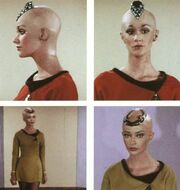
Khambatta's screen test on 27 October
- 27 October 1977: Persis Khambatta holds her screen test and is signed the following day as Ilia. She does not need to have her head shaven yet on this occasion, instead she wears a bald cap. (The Lost Series, p. 54)
- 11 November 1977: The decision is made by the studio to upgrade Phase II from a television movie to a full-blown theatrical motion picture production, for which the budget, initially set at $15 million dollars by CEO Michael Eisner, is by April 1978 already upped to $18 million dollars. (The Making of, pp. 47, 85; The Lost Series, pp. 69, 75)
- 21 November 1977: The executive upgrade decision is disseminated through the lower production echelons, and production on Phase II is suspended in order to ascertain the requirements for a motion picture production, save for the construction of the studio models. The start on the new production is moved up to March or April 1978 in order to make the necessary upgrade changes to scripts, sets, wardrobes, production assets, etc. Production crew such as make-up artists, hair dressers, cameramen, stand-in performers, set dressers and the like, just hired that week, are immediately fired. Veterans Matt Jefferies and Jim Rugg by that time had already left the production earlier that month, the former to return to his regular job. (The Making of, p. 47)
December 1977 – December 1979: Star Trek: The Motion Picture
- 1 December 1977: Post-production Supervisor Paul Rabwin, together with Roddenberry and Director Collins, inspect the studio models to see if they hold up in big-screen resolution. With them are Robert Abel and Richard Taylor of Robert Abel & Associates (RA&A) to help them out with the analysis. Both men realize that they do not. Construction on the models is now halted too. (The Lost Series, pp. 69)
- December 1977: Writers are blissfully unaware of the upgrade and episode scripts keep pouring in right until January. Povill, Livingston and Roddenberry intentionally keep them in the dark, by continuing to annotate their work. Yet, gossip columnist Rona Barrett does blow the whistle in her Rona Barret's Hollywood December issue tabloid, with her largely correct report that Phase II has been halted and that Roddenberry is offered an opportunity to make a theatrical movie. The studio goes on record vehemently denying the supposition, only willing to concede that the premiere has been postponed from February to Autumn 1978, and that the projected series is expanded from thirteen to between fifteen and twenty-two episodes. (The Lost Series, p. 67)
- 12 December 1977: Rabwin also inspects the sets and deems them salvageable, albeit with additional upgrading and detailing. To this end he has Director Collins and Camera Man Bruce Logan start shooting test footage and lens tests of the sets on this date, among others of the engineering set, but now with anamorphic lenses, required for wide-screen movies, to get a feel of how these sets will translate on theater screens. Shooting of this test footage continues throughout this, and the subsequent week. (The Lost Series, pp. 67, 73, color inset)
- 30 December 1977: Due to ever increasing creative differences with Roddenberry, causing the relationship between the two men to sour considerably, Producer Harold Livingston decides to leave the Star Trek production after turning in his last report, effective immediately. (The Lost Series, p. 73)
- Early January 1978: RA&A, who have tendered a bid of $4 million dollars, is signed for the visual effects for what is now Star Trek: The Motion Picture. Its namesake, Robert Abel, is the main responsible effects producer/director, whereas Taylor will serve as effects designer. [20] Brick Price Movie Miniatures is released from the production (Jein had already left after completion of his one assignment). It is now definitively decided to discard all the, in various states of completion, Phase II models and start all over again, with RA&A being responsible for the necessary redesigns. To this end Robert Abel establishes a subsidiary art department company, Astra Image Corporation (ASTRA), responsible for all art work and design. Aside from his visual effects duties, Richard Taylor is to serve as its Art Director, working on par with the Paramount's Art Department, headed by Jennings. Magicam, released from the visual effects production, is retained as a studio model shop only, and it is they who are to build the models. A noticeable addition to ASTRA is future Star Trek alumnus, Andrew Probert, who is to assist Taylor with the redesign work as production illustrator, most notably that of the Phase II Enterprise. (The Making of, p. 202; Star Trek: Creating the Enterprise, 1st ed, p. 46)
- 5 January 1978: In a budget allocation memo, Goodwin allows for a salary allotment for Leonard Nimoy as Spock, indicating that the production staff at least now considers Spock as instrumental for the new movie. Studio executives though, for reasons mentioned below, still hold out. (The Lost Series, p. 65)
- Early February 1978: While awaiting the redesigns, Magicam, upon receival of Taylor's blueprints, specifying the new movie dimensions, starts model construction with the build of the new Klingon battle cruiser studio model. The early start is facilitated by the fact that the basic design of the model is to remain unchanged. Magicam's Chris Ross is appointed lead modeler on the construction. (American Cinematographer, February 1980, p. 153)
- February 1978: Life returns to the abandoned and near-complete bridge set on Stage 9, as RA&A shoots test footage in order to ascertain visual effects requirements, with extras still clad in Original Series/Phase II uniforms. To this end, an internal document, "Enterprise" Flight Manual, intended to instruct the stage effects technicians on wiring up all of the work station's control panel backlits, working switches and indicator lights as well as giving performers basic button-pushing lessons, is distributed among the various departments that month, prior to shooting. The manual was a few months later updated to reflect the design changes that were implemented after April. (The Lost Series, pp. 78, 104-108)
- Late February 1978: Even though redesign work has just started up, construction is started on the new "hero model", the refit-Enterprise. This early start is made possible due to the fact that Roddenberry emphatically vetoes any notion of the radical redesign Taylor has in mind, ordaining that the lines as set by Jefferies are to be observed. Magicam's Chris Crumb, is appointed lead modeler on the build. (Star Trek: The Magazine Volume 2, Issue 8, p. 85; Starlog, issue 27, p. 29) Nevertheless, due to the fact that redesigned elements are continuously added, at first by Taylor and Probert and subsequently by Douglas Trumbull, means that the model will not be completed for another fourteen months. (The Making of, p. 207)
- Early March 1978: After negotiations that lasted for two months, Robert Wise is signed on as director and producer. he was already suggested by Jon Povill as one of the possible directors to direct Planet of the Titans back in 1976. Wise's unwillingness to share producer credit with "that kid in jeans", causes Robert Goodwin (who was thirty at the time) to leave the production in disgust. Phase II director, Robert Collins, too is released from the production. Povill is officially promoted from story editor to associate producer. As it will turn out, Wise is only to officially receive a director's credit, and not one as producer. That credit is reserved for Roddenberry only, even though his influence is considerably curtailed by the studio, after Wise comes aboard, who essentially takes over as the primary overseer of the production. (The Lost Series, p. 76)
- March 1978: One of the first things Wise does, is firing William Theiss, as he considers his costume designs sub-par. Wise brings Robert Fletcher aboard as the new costume designer. (The Lost Series, p. 62) Wise also brings along his regular production illustrator of many years, Maurice Zuberano, who is primarily tasked with the re-imagining of what is to become V'ger. (The Making of, pp. 81-82) As far as the Star Trek fanbase is concerned Wise's most important contribution this month is to bring back Leonard Nimoy as Spock. Wise, who in turn was enticed by his wife Millicent and her father, ardent Trekkies (which Wise himself was not) to do so, only accepted the assignment on the condition that Spock was brought back. Aside from the officially given reason that Nimoy did not want to commit to the rigors of a weekly show, there was an unofficial reason as well; Nimoy has since the end of the Original Series been involved in a conflict with the studio over residual amenities of the use of his likeness on merchandise, for which neither he, nor any of his co-stars, ever received any financial compensation. Up to that point the studio had steadfastly refused to give in, but now, on Wise's insistence, the studio caves and the conflict which had dragged for a decade is resolved within a week with a "check for a reportedly substantial figure", and Nimoy is signed on (The deal was advantageous for Shatner as well, since he and Nimoy had entered into a mutual covenant, which stipulated that, simply put, what the one got so did the other). This however, has ramifications for the Xon character, as it is now dropped as a principal character, and indeed, even the Decker character, which is not yet cast, is in doubt. Gautreux is offered the consolation role of Commander Branch. (The Lost Series, p. 77; Star Trek Movie Memories, 1995, pp. 87-88) Millicent will be rewarded for her input with a cameo as one of the Enterprise crewmembers, gathered for the briefing scene on the recreation deck of the refit-Enterprise, were she appeared alongside a multitude of other Star Trek fans. Wise's only child, son Rob Wise, will also serve on the movie as assistant cameramen, as is his nephew, Doug Wise, as assistant director. An important change this month, is Wise's addition of Richard H. Kline as director of photography, responsible for the principal photography. Kline thereby replaces Bruce Logan as such, who is made the main responsible cinematographer for the second-unit photography. (The Making of, pp. 79, 186)
- 28 March 1978: Star Trek: The Motion Picture is announced to the public at Paramount Pictures in the largest press conference held since the 1920s. (The Making of, pp. 50-51)
- April 1978: Gene Roddenberry begs Livingston to return as script development had hit a brick wall. Livingston only agrees to do so after a meeting with Wise and additionally secured guarantees from studio executives Michael Eisner and Jefferey Katzenberg, specifying his own working conditions and that he is to have as little as possible to do with Roddenberry. (The Lost Series, p. 76)
- Late April 1978: Harold Michelson is brought in by Director Wise as production designer, replacing Joe Jennings as head of the art department. Michelson is responsible to perform redesigns on the Phase II sets in their various states of completion for their motion picture use. Like Jennings, most of the art department staff stayed on as well. A new staff member is Production Illustrator Rick Sternbach, a future Star Trek alumnus, while remaining uncredited for The Motion Picture. (The Making of, pp. 85, 87)
- May 1978: RA&A, feeling compelled to do so by ever increasing studio demands, ups their original bid for the visual effects with $750,000, the first raise of many. (The Making of, p. 203)
- Mid-July 1978: Brick Price Movie Miniatures, previously released from the Star Trek production is now signed for (mostly) hand-held prop manufacturing, three weeks before the start of principal photography, though they were never to receive an official credit for it. (Starlog, issue 20, p. 71) The Klingon D7-class model is the first studio model completed and delivered for filming. Test footage is shot of the model, but Taylor decides that the model needs additional detailing and reverts the model back to Magicam/ASTRA for rework. (Starlog, issue 27, p. 29; American Cinematographer, February 1980, p. 179)
- 19 July 1978: Shooting script.
- 24 July 1978: In a memo Roddenberry informs the studio that RA&A has made an additional $220,700 request for the visual effects. Sensing that problems are brewing, Roddenberry advises the studio to appoint liaisons between RA&A and the studio. Michael Eisner immediately responds by appointing Richard Yuricich (as of yet unpaid) to the production and concurrently instructing studio executives Katzenberg and Lindsey Parsons Jr. to spend more of their time to the project. (The Making of, pp. 203-204)
- 25 July 1978: After nearly a full year, the role of Captain Decker is still to be filled, when a final round of cast interviews is held. The continuous script rewrites, resulting in perpetuous changes in the characterization of Decker – even going as far as considering whether or not the character is needed at all for the movie – , are in no small measure contributing to the arduous process of filling the role. Nine actors are interviewed this day, aside from Stephen Collins, Andrew Robinson too is interviewed for the role. (The Making of, p. 104)
Phillips working on Khambatta
- 26 July 1978: Make-up artist Fred Phillips shaves Persis Khambatta's head in preparation for her role. (The Making of, p. 6) The act is recorded and later included in the documentary The Making of Star Trek: The Motion Picture and in the special feature "A Bold New Enterprise" on the 2001 Star Trek: The Motion Picture (The Director's Edition) DVD release.
- 1 August 1978: Stephen Collins is signed for the role of Decker. Decker is the final primary character to be cast. The passed-over Robinson is yet to return to the Star Trek franchise. (The Making of, p. 6)
- 7 August 1978: Principal photography begins with Scene 64 featuring Sulu and Chekov and taking place on the bridge set on Stage 9, where the camera pans the set, right before Admiral Kirk's arrival, is the first scene filmed. William Shatner is on hand to shoot his Kirk scenes later that day. Due to fatigue, a close-up on Shatner's face is postponed to the following day, constituting already the very first shooting schedule delay. Photography is started without the benefit of a completed script, which is still lacking an ending. Writing and re-writing of script drafts will continue unabated over the course of the subsequent months. (The Making of, pp. 1-7, 57)
- 8 August 1978: The second-unit film crew moves to Yellowstone Park and starts filming the planet Vulcan sequence. Director Wise and performer Nimoy, for his first Spock sequences, join them shortly, and the sequence will take three days to film. (The Making of, p. 173)
- 16 October 1978: The crew gathering sequence for Kirk's mission briefing on the just completed recreation deck set on Stage 8 is shot. Assembled are 300 extras of which 100 males and 25 females are notable Star Trek fans, like Bjo Trimble and Denise Tathwell; the others are Screen Extras Guild performers, with an additional number of production staff affiliates like Susan Sackett and Millicent Wise. The shooting concludes the following day and the extras are released with a few exceptions for an additional shot on the overhead catwalk. (Starlog, issue 32, pp. 57-58)
- 24 November 1978: Walter Koenig finishes his Chekov sequences and is released from the production. His subsequent presence will only be required for promotional and public relations purposes. (Starlog, issue 32, p. 61)
- 29 November 1978: The completed and final script draft is distributed at last, with only a mere two months left on principal photography. (The Making of, p. 57)
- Late December 1978: By Christmas, the situation with RA&A is spiraling out of control and creative and financial conflicts between the company and the studio intensify to breaking point. Douglas Trumbull, who only one year earlier had turned down the visual effects assignment, is brought in as an unpaid technical consultant. Trumbull, who by then has a very strained relationship with the studio, only agreed to do so as a courtesy to his old fried Bob Wise, who personally requested his input. (The Making of, p. 203)
- 26 January 1979: Principal photography ends, with scene 391, the "V'ger fusion" scene between Decker and the Ilia-probe, the very last scene shot. Originally scheduled to finish on 31 October 1978 (shortly thereafter revised to 22 December), principal photography as initially budgeted is three months overdue. At $4,000 a day for stage time, this means an additional over budget cost of roughly $250,000 for principal photography alone. Three second-unit scenes though, for which the principal cast was not needed, the San Fransisco air tram station, the Klingon bridge and the Epsilon IX bridge sequences, still remain outstanding, as are the visual effects sequences. These sequence will be shot throughout the spring and summer, the visual effect ones extending well into the autumn of 1979. (The Making of, pp. 7, 188, 191-193)
- 10 February 1979: The traditional "wrap party", celebrating the end of principal photography, is held at Liu's Chinese Restaurant and Chez Moi Disco on 140 South Rodeo Drive, Beverly Hills, and is open to everyone involved with the Motion picture and their retinue. (The Making of, p. 195)
- 22 February 1979: Studio executives and producers come sizing up the visual effects situation at Robert Abel & Associates. The company reportedly had only a single completed effects shot to show for all the time and money spent, already four million dollars over budget at sixteen million dollars by December 1978. In an acrimonious atmosphere, Abel is fired on the spot and his company released, effective immediately, starting a frantic search for a replacement, as the studio now unexpectedly finds itself extremely pressured for time since the release date for the movie was a given. (The Special Effects of Trek, pp. 29, 31)
- Early March 1979: Douglas Trumbull's visual effects company, Future General Corporation, is signed for the visual effects. Both his and co-founder Richard Yuricich's participation in the production now becomes formal. Trumbull in turn sub-contracts John Dykstra's Apogee, Inc. in order to divide the workload. (see above)
- March 1979: While devising the visual effects shots, Trumbull brings in Robert McCall, with whom he had already worked before on 2001: A Space Odyssey and where the two men became close friends, as production illustrator in order to help out with visualizing the various V'ger scenes. Much of what McCall, who had been passed over for Mike Minor nearly two years earlier, will conceive is indeed translated onto screen by Trumbull. (Star Trek: The Magazine Volume 2, Issue 8, pp. 70-73) During this month, the San Fransisco air tram station sequence is filmed. William Shatner has to return for this sequence. Shatner is the only principal cast member who has to return to the production, after principal photography had wrapped. (The Making of, p. 193)
- 29 November 1979: Last visual effects shot is completed. (Cinefex, issue 1, p. 4)
- December 1979: Novelization.
- December 1979: The documentary The Making of Star Trek: The Motion Picture, a specialty promotional tool, is shown nation wide at public venues, such as train stations.
- December 1979: Marvel Comics Super Special #15 (comic adaptation).
- December 1979: Soundtrack LP record release.
- December 1979: View-Master adaptation.
- 5 December 1979: Post-production work is finally finished and the final cut of the movie is delivered for distribution. (Cinefex, issue 1, p. 4)
- 6 December 1979: Washington, DC premiere.
- 7 December 1979: US theatrical premiere.
- 13 December 1979: Sydney, Australia theatrical premiere.
- 20 December 1979: UK theatrical premiere.
- 21 December 1979: Melbourne, Australia and Ireland theatrical premieres.
1980s releases and merchandising
- 1980: Photostory adaptation.
- 1980: Star Trek: The Motion Picture Blueprints.
- 1 January 1980: Australia theatrical general release.
- 17 January 1980: Argentina (as Viaje a las estrellas: La película) theatrical premiere.
- March 1980: The Making of Star Trek: The Motion Picture (book).
- 18 March 1980: Spain (as Star Trek - La película) and Brazil (as Jornada nas Estrelas: O Filme) theatrical premieres.
- 19 March 1980: France (as Star Trek, le film) theatrical premiere.
- 21 March 1980: Portugal (as O Caminho das Estrelas) theatrical premiere.
- 27 March 1980: West Germany (as Star Trek: Der Film) theatrical premiere.
- 28 March 1980: Finland (as Star Trek: Avaruusmatka) theatrical premiere.
- 2 April 1980: Sweden theatrical premiere.
- 7 April 1980: Norway and Denmark premieres.
- 17 April 1980: Brazil (as Jornada nas Estrelas: O Filme) theatrical premiere.
- April 1980: Marvel TOS #1 (comic reprint 1 of 3).
- May 1980: Marvel TOS #2 "V'ger" (comic reprint 2 of 3).
- June 1980: Marvel TOS #3 "Evolutions" (comic reprint 3 of 3).
- 19 June 1980: Netherlands theatrical premiere.
- 5 July 1980: Japan theatrical premiere.
- October 1980: US video release (VHS and Beta formats).
- 25 October 1980: Taiwan theatrical premiere.
- 22 March 1981: Capacitance Electronic Disc (CED).
- 1981: US LaserDisc.
- 1981: UK LaserDisc.
- 4 September 1981: Iceland theatrical premiere.
- 26 October 1981: Turkey (as Uzay Macerasi) theatrical premiere.
- 20 February 1983: US Network Television Premiere on ABC Television Network as the first public showing of what came to be called the "Special Longer Version" .
- 1983: US LaserDisc (Special longer version).
- 1983: US Betamax (Special longer version).
- 3 September 1984: UK television premiere on ITV.
- 1985: Japan VHD.
- 7 July 1985: Japan LaserDisc.
- 1986: Soundtrack CD 1st release.
- 25 April 1986: East Germany theatrical premiere.
1990s merchandising
- 25 October 1990: Soundtrack CD 2nd release.
- 1991: France LaserDisc.
- 1991: Germany LaserDisc.
- 1991: Netherlands LaserDisc.
- 7 December 1992: VHS.
- 10 March 1994: Japan LaserDisc.
- 1994: Germany VideoCD.
- 2 April 1997: VHS Widescreen.
- 26 January 1999: Soundtrack CD 20th Anniversary Collector's Edition.
2000s merchandising
- 6 November 2001: Director's Edition theatrical premiere.
- 9 November 2001: Director's Edition Region 1 DVD.
- 13 May 2002: Director's Edition Region 2 DVD.
- 12 May 2009: Original theatrical release Blu-ray.
- 5 June 2012: Soundtrack release, La-La Land Records.
- 30 April 2013: Star Trek I: The Motion Picture [Blu-ray] Directors Edition (reported).
Merchandise gallery
Apocrypha
- The novelization of TNG: "Encounter at Farpoint" establishes that Captain Picard first boarded the Enterprise-D via shuttlecraft, a process later canonized in TNG: "All Good Things...". According to the novel, Picard recalled how the then-Admiral Kirk had unwittingly begun a tradition of captains coming to their ship for the first time via shuttle instead of transporting aboard including the irony that no one really thought of the fact that Kirk traveled to Enterprise in a travel pod because of a serious transporter malfunction.
- The novel The Return, written by William Shatner, states that the "Living Machines" that Voyager 6 encountered on its journey were the Borg.
- The novel Ex Machina establishes that of all the original crew, only Scotty and Uhura were long term members of then-Captain Decker's crew. Chekov and Sulu had only been assigned back to Enterprise only hours before Kirk transferred aboard, as Admiral Nogura wanted as many of the original command crew back on the ship as was possible for the emergency mission. According to the film, Scotty had been working on the refit and according to the novel, Decker had personally recruited the entire crew, making it the most diverse of species ever seen aboard a starship up until that point. Decker had even recruited Uhura to help recruit many of the nonhuman crewmembers. During a conversation between Sulu and Uhura, Sulu mentions that Decker was considering making Uhura his executive officer, thus adding new subtext to her first line spoken while on the bridge during prelaunch: " my people are all tied up here!".
Awards and honors
Star Trek: The Motion Picture received the following awards and honors.
| Year | Group | Award | Nominee(s) | Result |
|---|---|---|---|---|
| 1980 | Academy Awards | Art Direction | Art Direction: Harold Michelson, Joe Jennings, Leon Harris, John Vallone; Set Decoration: Linda DeScenna | Nominated |
| Music (Original Score) | Jerry Goldsmith | |||
| Visual Effects | Douglas Trumbull, John Dykstra, Richard Yuricich, Robert Swarthe, Dave Stewart, Grant McCune | |||
| Golden Globe Awards | Best Original Score - Motion Picture | Jerry Goldsmith | ||
| Hugo Awards | Best Dramatic Presentation | Screenplay by Harold Livingston, Story by Alan Dean Foster and Gene Roddenberry, Directed by Robert Wise | ||
| Saturn Awards | Best Make-Up | Fred B. Phillips, Janna Phillips, Ve Neill | ||
| Best Costumes | Robert Fletcher | |||
| Best Music | Jerry Goldsmith | |||
| Best Supporting Actress | Nichelle Nichols | |||
| Best Supporting Actor | Leonard Nimoy | |||
| Best Actress | Persis Khambatta | |||
| Best Actor | William Shatner | |||
| Best Director | Robert Wise | |||
| Best Science Fiction Film | - | |||
| Best Special Effects | Douglas Trumbull, Richard Yuricich, John Dykstra | Won | ||
| 2001 | DVD Exclusive Awards | Best Audio Commentary | Robert Wise, Douglas Trumbull, John Dykstra, Jerry Goldsmith, Stephen Collins | Nominated |
| Best Overall New Extra Features, Library Title | - | |||
| Best DVD Menu Design | 1K Studios | |||
| Best New, Enhanced or Reconstructed Movie Scenes | Producer: David C. Fein, Restoration Supervisor: Michael Matessino, Visual Effects Supervisor: Daren Dochterman | Won | ||
| 2002 | Saturn Awards | Best DVD Classic Film Release | - | Nominated |
| 2012 | IFMCA Awards | Best Archival Release of an Existing Score | Music by Jerry Goldsmith, Album Produced by Didier C. Deutsch, Mike Matessino, Bruce Botnick, MV Gerhard, Matt Verboys and David C. Fein, Liner Notes by Jeff Bond and Mike Matessino, Album Art Direction by Jim Titus (La-La Land) | Won |
Links and references
Credits
- All credits
- Uncredited co-stars
- Richard Arnold as an Enterprise crewmember
- Rosanna Attias as an Enterprise crewmember
- Fred Bronson as an Enterprise crewmember
- Bobby Butz as an Enterprise crewmember
- Gordon Cardoza as an Enterprise crewmember
- Celeste Cartier as an Enterprise crewmember
- JoAnn Christy as a Vulcan science division crewmember
- Vern Dietsche as an Enterprise crewmember
- Christopher Doohan as an engineering crewmember
- Montgomery Doohan as a science division crewmember
- Walt Doty as an Enterprise crewmember
- John Dresden as a Starfleet security officer
- Scott Dweck as a Vulcan science division crewmember
- Don Fanning as a Zaranite Enterprise crewmember
- Dennis Fischer as an engineering crewmember
- Cassandra Foster as an Enterprise crewmember
- Barnetta Fowler as an Enterprise crewmember
- David Gerrold as a command division crewmember
- Brenda Gooch as an Enterprise crewmember
- William Guest as an Enterprise crewmember
- John Hayes as an Enterprise crewmember
- Sharon Hesky as a Federation civilian
- Bill Hickey as a science division crewmember
- Betty Kennedy as a Federation civilian
- James T. Kirk as an Enterprise crewmember
- Katherine Kurtz as an Enterprise crewmember
- Art Lake as an Enterprise crewmember
- Steven Lance as a Rhaandarite Enterprise crewmember
- Randall Larson as an Enterprise crewmember
- Don J. Long as an Enterprise crew member
- Greg Mace as an Enterprise crewmember [21]
- Winnie McCarthy as an Unnamed Epsilon IX technician
- Michelle as an Enterprise crewmember
- Barbara Minster as an Enterprise crewmember
- Beth Moberly as an Enterprise crewmember
- Ve Neill as an Enterprise crewmember
- Zack Richardson as an Enterprise crewmember
- Linda Robertson as an Enterprise crewmember
- Susan Sackett as a science division crewmember
- Eileen Salamas as an Enterprise crewmember
- Frank Salsedo as Enterprise crewmember
- Kaith Shiozaki as an Enterprise crewmember
- Kathleen Sky as an Enterprise crewmember
- Jay Smith as an Enterprise crewmember
- Louise Stange-Wahl as a science division crewmember
- Leigh Strother-Vien as an Enterprise crewmember
- Cedric Taporco as a Saurian Enterprise crewmember
- Denise Tathwell as an Enterprise crewmember
- H. Teague as an Unnamed Epsilon IX technician [22]
- Bjo Trimble as a science division crewmember
- Vincent as a Saurian Enterprise crewmember
- John Watts as an Andorian Enterprise crewmember
- Green Whitaker as a Federation civilian
- Marlene Willauer as a civilian crewmember
- Millicent Wise as an engineering crewmember
- Unknown performers as
- Uncredited stunt performers
- Lightning Bear
- Tom Morga as
- Kim Washington as stunt double for Nichelle Nichols
- Uncredited production staff
- Robert Abel - Astra Image Corporation: Special Effects
- Bernie Abramson - Second Unit Director of Photography
- John L. Black - Key Grip
- Jim Chirco - Craft Serviceman
- Bill George - Apogee, Inc.: Model Maker
- Ron Gress - Entertainment Effects Group: Model Painter
- John Grower - Astra Image Corporation
- William Guest - Special Effects: Special Props and Miniatures
- Pierre Jalbert - Editor/Dialogue Editor
- Dennis Jones - Sound-Boom Man
- Alexander Lepak - Percussionist
- Michael Lynn - Costumer
- Dan Maltese - Set Designer
- William Mass - Costumer
- Lisa Morton - Apogee, Inc.: Model Maker
- Steve Neill - Makeup Artist
- Debbi Nikkel - Apogee, Inc.: Production Accountant
- Don Pennington - Apogee, Inc.: Model Maker
- Charlie Schram - Makeup Artist
- Rick Sternbach - Production Illustrator
- Rick Stratton - Lab Technician: Makeup Department
- William Sully - Illustrator
- Carlos Yeaggy - Makeup Artist
References
1999; Amar, IKC; Andorians; air tram; Air tram 3; Air tram 14; air tram station; asteroid; astronomical unit; audiovisual association; binary code; biofunction monitor; black hole; bluff; carbon-based lifeform; carbon unit; carrier wave; cc; Columbia, USS; com station; Constitution-class; Conrad; courier; Creator; dalaphaline; drydock; Deltans; Delta IV; Doctor of Medicine; Earth; emotion; Entente, USS; Enterprise, USS; Epsilon IX station; exocrine system; field coil; flight deck; flow sensors; God; Golden Gate Bridge; grade 1 priority; ground test computer; inertial stabilizer; Klingons; kolinahr; K't'inga-class; Laika; light cube table; linguacode; lunar beacon; machine planet; megahertz; Merrimac, USS; micro-miniature hydraulics; molecule; multiprocessor chip; NASA; navigational deflectors; Nogura; oath of celibacy; orbital office complex; osmotic micropump; plasma energy; photic sonar; planetary defense system; pons; Probert; Quad L-14; Quasar 7; radio; recreation deck; remote communications drone; Revere, USS; San Francisco; San Francisco-Oakland Bay Bridge; sensor drone; Sol; Sol system; space matrix restoration coil; spanking; spinal nerve fiber connection; spray applicator; Starfleet Operations; Starfleet Order 2005; Surak; thruster suit; tractor beam; transporter sensor; travel pod; Travel pod 5; twelfth power; V'ger; Voyager 6; Vulcan; Vulcan (planet); Vulcan embassy; Vulcan master; Vulcan mind meld; Vulcan nerve pinch; wormhole; wormhole effect; Yerba Buena Island
Background references
Aaamazzarites; Arcturians; Betelgeusians; Enterprise; USS Enterprise XCV 330; Federation-class; Hermes-class; K'normians; Kazarites; Megarites; Ptolemy-class; Rhaandarites; Rigellians; Saladin-class; Saurians; Shamin; Zaranites
Further reading
- American Cinematographer, February 1980 - The Motion Picture theme issue
- The Making of Star Trek: The Motion Picture, March 1980
- "Star Trek: The Emotional Picture", Chapter 4, Star Trek Movie Memories, August 1995, pp. 81-124
- "The Dream Fulfilled: STAR TREK THE MOTION PICTURE", Part Two-Chapter One, The Art of Star Trek, November 1995, pp. 153-200
- Star Trek Phase II: The Lost Series, March 1997
- Star Trek: The Magazine Volume 2, Issue 8, December 2001 - The Motion Picture theme issue
- Star Trek: Creating the Enterprise, December 2012
External links
- Star Trek: The Motion Picture at Wikipedia
- Template:IMDb-link
- Faces in the crowd - exhaustive list of fan extras compiled by Ian McLean
- Star Trek I: The Motion Picture at StarTrek.com
- Template:NCwiki-title
| Previous film: First film in series |
Star Trek films | Next film: Star Trek II: The Wrath of Khan |

